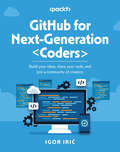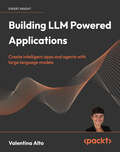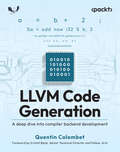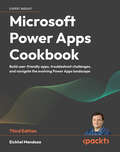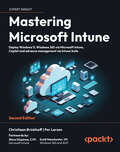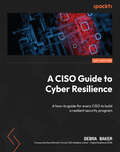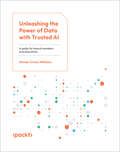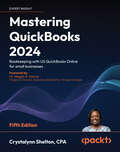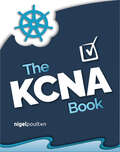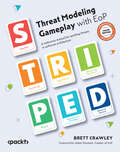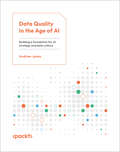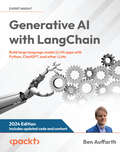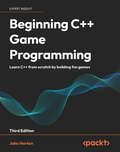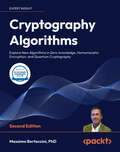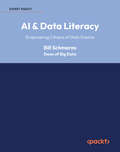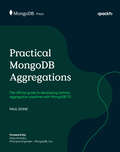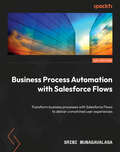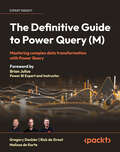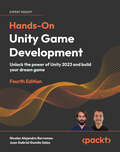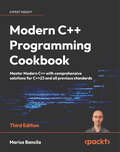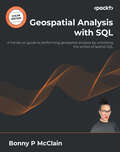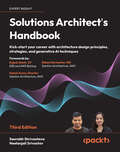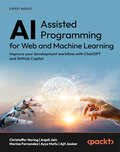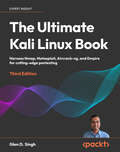- Table View
- List View
GitHub for Next-Generation Coders: Build your ideas, share your code, and join a community of creators
by Igor IrićBuild a powerful portfolio on GitHub that showcases your most impressive coding projects and technical skillsKey FeaturesExplore GitHub's powerful features and make it the central hub for all your coding adventuresLearn how to use GitHub Copilot as your coding sidekick, suggesting lines of code to help you write faster and smarterLearn how to optimize and personalize your GitHub profiles for maximum impact from a community leaderPurchase of the print or Kindle book includes a free PDF eBookBook DescriptionNavigating the world of collaborative software development can be daunting, especially for young coders just starting their programming journey. This book is designed to take you on a coding adventure, transforming you from a curious beginner into a confident GitHub user. The book builds a solid foundation and explains the Git version control system in depth, helping you understand how to track changes, collaborate effectively, and manage your projects with ease. You'll master repositories, the building blocks of your coding projects, and learn branching strategies to experiment and work seamlessly with others. The chapters will teach you about GitHub Actions, guiding you through workflow syntax, exploring environments and secrets management, and providing hands-on exercises to solidify your understanding. You’ll also discover how to craft a compelling GitHub profile that highlights your achievements and discover the exciting world of open-source projects where you can contribute and give back to the community. To get you started with AI, you’ll also learn how to leverage Copilot and ChatGPT together to write faster, cleaner code. By the end of this book, you’ll be well prepared to contribute to real-world projects on GitHub, equipped with the skills to thrive in the world of collaborative software development.What you will learnTravel back in code history and track different versions of your projectsKeep your code blocks neat and tidy within your repository, just like sorting puzzle pieces to create a masterpieceCreate branches to experiment with new ideas or features without messing up your main codeUse Git to share your suggestions and collaborate with other coders to make your code even more amazingAutomate and level up your coding game with GitHub ActionsBuild your coder reputation by contributing to open source projectsWho this book is forThis book is for young, tech-curious individuals eager to find out more about the world of software development. If you are a student motivated to learn GitHub to better understand collaborative coding practices, manage projects effectively, and potentially pursue careers or hobbies in the technology field, then this book is for you.
Building LLM Powered Applications: Create intelligent apps and agents with large language models
by Valentina AltoGet hands-on with GPT 3.5, GPT 4, LangChain, Llama 2, Falcon LLM and more, to build LLM-powered sophisticated AI applicationsKey FeaturesEmbed LLMs into real-world applicationsUse LangChain to orchestrate LLMs and their components within applicationsGrasp basic and advanced techniques of prompt engineeringBook DescriptionBuilding LLM Powered Applications delves into the fundamental concepts, cutting-edge technologies, and practical applications that LLMs offer, ultimately paving the way for the emergence of large foundation models (LFMs) that extend the boundaries of AI capabilities. The book begins with an in-depth introduction to LLMs. We then explore various mainstream architectural frameworks, including both proprietary models (GPT 3.5/4) and open-source models (Falcon LLM), and analyze their unique strengths and differences. Moving ahead, with a focus on the Python-based, lightweight framework called LangChain, we guide you through the process of creating intelligent agents capable of retrieving information from unstructured data and engaging with structured data using LLMs and powerful toolkits. Furthermore, the book ventures into the realm of LFMs, which transcend language modeling to encompass various AI tasks and modalities, such as vision and audio. Whether you are a seasoned AI expert or a newcomer to the field, this book is your roadmap to unlock the full potential of LLMs and forge a new era of intelligent machines.What you will learnExplore the core components of LLM architecture, including encoder-decoder blocks and embeddingsUnderstand the unique features of LLMs like GPT-3.5/4, Llama 2, and Falcon LLMUse AI orchestrators like LangChain, with Streamlit for the frontendGet familiar with LLM components such as memory, prompts, and toolsLearn how to use non-parametric knowledge and vector databasesUnderstand the implications of LFMs for AI research and industry applicationsCustomize your LLMs with fine tuningLearn about the ethical implications of LLM-powered applicationsWho this book is for Software engineers and data scientists who want hands-on guidance for applying LLMs to build applications. The book will also appeal to technical leaders, students, and researchers interested in applied LLM topics. We don’t assume previous experience with LLM specifically. But readers should have core ML/software engineering fundamentals to understand and apply the content.
LLVM Code Generation: A deep dive into compiler backend development
by Quentin ColombetExplore the world of code generation with the LLVM infrastructure, and learn how to extend existing backends or develop your ownKey FeaturesUnderstand the steps involved in generating assembly code from LLVM IRLearn the key constructs needed to leverage LLVM for your hardware or backendStrengthen your understanding with targeted exercises and practical examples in every chapterPurchase of the print or Kindle book includes a free PDF eBookBook DescriptionThe LLVM infrastructure is a popular compiler ecosystem widely used in the tech industry and academia. This technology is crucial for both experienced and aspiring compiler developers looking to make an impact in the field. Written by Quentin Colombet, a veteran LLVM contributor and architect of the GlobalISel framework, this book provides a primer on the main aspects of LLVM, with an emphasis on its backend infrastructure; that is, everything needed to transform the intermediate representation (IR) produced by frontends like Clang into assembly code and object files. You’ll learn how to write an optimizing code generator for a toy backend in LLVM. The chapters will guide you step by step through building this backend while exploring key concepts, such as the ABI, cost model, and register allocation. You’ll also find out how to express these concepts using LLVM's existing infrastructure and how established backends address these challenges. Furthermore, the book features code snippets that demonstrate the actual APIs. By the end of this book, you’ll have gained a deeper understanding of LLVM. The concepts presented are expected to remain stable across different LLVM versions, making this book a reliable quick reference guide for understanding LLVM.What you will learnUnderstand essential compiler concepts, such as SSA, dominance, and ABIBuild and extend LLVM backends for creating custom compiler featuresOptimize code by manipulating LLVM's Intermediate RepresentationContribute effectively to LLVM open-source projects and developmentDevelop debugging skills for LLVM optimizations and passesGrasp how encoding and (dis)assembling work in the context of compilersUtilize LLVM's TableGen DSL for creating custom compiler modelsWho this book is forThis book is for both beginners to LLVM and experienced LLVM developers. If you’re new to LLVM, it offers a clear, approachable guide to compiler backends, starting with foundational concepts. For seasoned LLVM developers, it dives into less-documented areas such as TableGen, MachineIR, and MC, enabling you to solve complex problems and expand your expertise. Whether you’re starting out or looking to deepen your knowledge, this book has something for you.
Microsoft Power Apps Cookbook: Build user-friendly apps, troubleshoot challenges, and navigate the evolving Power Apps landscape
by Eickhel MendozaLearn the art of Power Apps with hands-on recipes for development, automation, and AI-powered solutions, combining Power Apps with components of the Power Platform such as Power Automate, Dataverse, Power BI, and Power Pages. Purchase of the print or Kindle book includes a free PDF eBook.Key FeaturesExplore how to build apps without custom IT developmentAccelerate development with the AI-powered Microsoft Copilot as your virtual app making partnerCreate intuitive and responsive interfaces with canvas app UI elementsBook DescriptionIn the rapidly evolving world of low-code development, Microsoft Power Apps stands out as a powerful platform for building custom business solutions. Microsoft Power Apps Cookbook, 3rd Edition, is your hands-on guide to mastering this platform. Through a collection of step-by-step recipes, this updated edition helps you navigate the latest features, such as AI-powered Microsoft Copilot and custom UI elements while empowering you to build efficient and scalable apps. This book emphasizes practical solutions, guiding app makers through building everything from canvas apps to complex data integrations. You will learn how to streamline repetitive tasks using Robotic Process Automation (RPA) and explore how to create external-facing websites using Microsoft Power Pages while handling data management with Dataverse and extending app functionality with the Power Apps Component Framework. Whether you're extending your app's capabilities with custom components or integrating advanced AI features, Microsoft Power Apps Cookbook equips you with the knowledge and skills to take your app development to the next level.What you will learnDevelop responsive apps with Canvas and Model-Driven frameworksLeverage AI-powered Copilot to accelerate your app developmentAutomate business processes with Power Automate cloud flowsBuild custom UI components with the Power Apps Component FrameworkImplement data integration strategies using DataverseOptimize your app for performance and smooth user experiencesIntegrate Robotic Process Automation (RPA) and Desktop flowsBuild secure, scalable, external-facing websites using Microsoft Power PagesWho this book is forThis book is targeted at information workers and app makers wanting to develop custom applications for their organizations or the projects they are undertaking. Traditional app developers will also find this book useful by discovering how to use a rapid application development environment with increased productivity and speed. Readers are expected to have prior exposure to the Microsoft Power Platform ecosystem.
Mastering Microsoft Intune: Deploy Windows 11, Windows 365 via Microsoft Intune, Copilot and advance management via Intune Suite
by Christiaan Brinkhoff Per LarsenGet ready to master Microsoft Intune and revolutionize your endpoint management strategy with this comprehensive guide and provide next-level security with the Intune Suite. Includes forewords from Scott Manchester, Vice President, Windows 365 + AVD and Steve Dispensa Corporate Vice President, Microsoft Intune.Key FeaturesThis new edition covers the latest updates of Microsoft Intune, Windows 365, Intune Suite, Windows Autopatch, Microsoft Defender and Universal PrintGet detailed guidance on device enrolment, app deployment, management, data security, and policy configurationSecure data on personal devices with app policies, encryption, and moreBook DescriptionThe slow adoption of modern Work solutions, which are designed to streamline the management of your environment, can often be attributed to a lack of understanding and familiarity with those solutions. This book will provide you with all the information you need to successfully transition to Microsoft Intune. Mastering Microsoft Intune, Second Edition, explains various concepts in detail to give you the clarity on how to use Microsoft Intune and eliminate any migration challenges. You'll master Cloud Computing services such as Windows 365 Cloud PCs, Intune Suite, Windows Autopatch, Windows Autopilot, profile management, monitoring and analytics, Universal Print, and much more. The book will take you through the latest features and new Microsoft Cloud services to help you to get grips with the fundamentals of Intune and understand which services you can manage. Whether you're interested in physical or cloud endpoints it's all covered. By the end of the book, you'll be able to set up Intune and use it to run Windows and Windows 365 efficiently, using all the latest features of Intune.What you will learnSimplify the deployment of Windows in the cloud with Windows 365 Cloud PCsDeliver next-generation security features with Intune SuiteSimplify Windows Updates with Windows AutopatchConfigure advanced policy management within IntuneDiscover modern profile management and migration options for physical and Cloud PCsHarden security with baseline settings and other security best practicesFind troubleshooting tips and tricks for Intune, Windows 365 Cloud PCs, and moreDiscover deployment best practices for physical and cloud-managed endpointsWho this book is forIf you're an IT professional, enterprise mobility administrator, architect, or consultant looking to learn about managing Windows on both physical and cloud endpoints using Microsoft Intune, then this book is for you.
A CISO Guide to Cyber Resilience: A how-to guide for every CISO to build a resilient security program
by Debra BakerExplore expert strategies to master cyber resilience as a CISO, ensuring your organization's security program stands strong against evolving threatsKey FeaturesUnlock expert insights into building robust cybersecurity programsBenefit from guidance tailored to CISOs and establish resilient security and compliance programsStay ahead with the latest advancements in cyber defense and risk management including AI integrationPurchase of the print or Kindle book includes a free PDF eBookBook DescriptionThis book, written by the CEO of TrustedCISO with 30+ years of experience, guides CISOs in fortifying organizational defenses and safeguarding sensitive data. Analyze a ransomware attack on a fictional company, BigCo, and learn fundamental security policies and controls. With its help, you’ll gain actionable skills and insights suitable for various expertise levels, from basic to intermediate. You’ll also explore advanced concepts such as zero-trust, managed detection and response, security baselines, data and asset classification, and the integration of AI and cybersecurity. By the end, you'll be equipped to build, manage, and improve a resilient cybersecurity program, ensuring your organization remains protected against evolving threats.What you will learnDefend against cybersecurity attacks and expedite the recovery processProtect your network from ransomware and phishingUnderstand products required to lower cyber riskEstablish and maintain vital offline backups for ransomware recoveryUnderstand the importance of regular patching and vulnerability prioritizationSet up security awareness trainingCreate and integrate security policies into organizational processesWho this book is forThis book is for new CISOs, directors of cybersecurity, directors of information security, aspiring CISOs, and individuals who want to learn how to build a resilient cybersecurity program. A basic understanding of cybersecurity concepts is required.
Unleashing the Power of Data with Trusted AI: A guide for board members and executives
by Wendy Turner-WilliamsDiscover the transformative potential of AI for data-driven decision-making and fast-track your organization's growth journey with trusted AI implementationKey FeaturesGain comprehensive insights and analyses to make quick and accurate decisionsLearn to integrate trusted AI into your organizational workflows and decision-making processesExplore real-world case studies that showcase the transformative impact of AI in diverse industriesPurchase of the print or Kindle book includes a free PDF eBookBook DescriptionWritten by a distinguished leader and innovator who has been instrumental in spearheading digital, cloud, and AI transformations across global brands, Unleashing the Power of Data with Trusted AI is an indispensable resource that will make you AI-ready. This comprehensive guide is designed to meet the urgent need for clarity and to give you actionable insights into today's rapidly evolving landscape of AI and its fundamental driver - data. You’ll delve into the exciting world of AI and its integration with data, uncover its significance, ethical considerations, and strategic applications with real-life success stories from industry giants like Starbucks, Netflix, and Siemens. You’ll also witness first-hand how the integration of data and AI has reshaped markets and elevated customer experiences, and discover the future of generative AI based on several surveys and case studies. You’ll gain an understanding of how AI has evolved across industries, empowering decision-making and fostering innovation. Tailored for board members, executives, innovators, and tech enthusiasts, this immersive guide will reshape your understanding of data and AI synergy. By the end of this guide, you’ll be able to lead your teams, customers, partners, and organizations confidently and responsibly in the era of AI.What you will learnNavigate ethical considerations and comply with data regulations effectivelyElevate data quality and enhance data literacy within your organizationCraft effective AI strategies for data analytics processesExplore real-world case studies showcasing the tangible benefits of trusted AIOptimize decision-making processes by harnessing AI-driven insightsWho this book is forThis report is for executives and board members of mid to large enterprises, such as CDAIOs, CTOs, CIOs, CISOs, CPOs, and CEOs, as well as AI, data, ethics, privacy, and security professionals. With this book, you’ll confidently develop your data and AI implementation strategy and navigate the complex landscape of emerging technologies with clarity.
Mastering QuickBooks 2024: Bookkeeping with US QuickBooks Online for small businesses
by Crystalynn SheltonTake control of your business finance by using QuickBooks Online for US for your accounting, budgeting, and reporting.Key FeaturesLearn to use QBO from scratch following professional CPA advice, accompanied with fully-updated instructions and screenshotsTailor QBO to your specific business needs with customization and integrationStreamline your billing, expense tracking, and financial reportingBook DescriptionIn today's competitive business landscape, efficient financial management is crucial for success. QuickBooks Online has emerged as the go-to accounting software for small businesses, offering a user-friendly platform to manage finances, track expenses, and gain valuable insights. This new edition will help you use QuickBooks Online from scratch and customize it to suit your small business needs. Written by accounting expert Crystalynn Shelton, it takes you on an in-depth journey, from setting up your account to mastering advanced features and customizations. This book empowers you to conquer the latest features of QuickBooks Online 2024, overcome challenges encountered during migration from desktop to online; plan cash flow, profits, revenue with precision; and streamline billing, expense tracking, and financial reporting. As you progress, you’ll learn to manage sales tax, including how to set up, collect, track, pay, and report sales tax payments. You’ll explore how to export reports to Google Sheets, use the custom chart builder, import budgets, and perform smart reporting with with using data sync with Excel. You'll learn how to tailor QuickBooks Online to your specific business needs. By the end of the book, you’ll master the art of QuickBooks Online and take control of your business financesWhat you will learnA crash course on basic accounting conceptsOvercome challenges encountered during migration from QBD to QBORecord income and expenses, pay vendors, and manage payrollStreamline client billing with invoicing and quoting templatesUse QuickBooks Online for tax filing and deadline managementPlan cash flow, profits, and revenue with the Report CenterCustomize financial reports and sales forms for your requirementsCalculate depreciation and automate workflows with QBO AdvancedWho this book is forThe book is for small business owners, bookkeepers, and accounting students who want to learn QuickBooks Online and understand how to implement it effectively. Whether you’re a bookkeeping beginner or have some experience already, this book will help you learn to use Intuit QuickBooks Online confidently.
The KCNA Book: Pass the Kubernetes and Cloud Native Associate exam in style
by Nigel PoultonBoost your knowledge with the well-organized revision guide for Kubernetes and Cloud Native Associate (KCNA) certification and exam. Expand your horizon of possibilities with extensive explanations and quizzesKey FeaturesLearn new technologies and revise concepts to master the KCNA certification and examReinforce and test knowledge through practice questions and an examBoost your career by leveraging Kubernetes and cloud-native technologiesBook DescriptionThere is a huge benefit in building small, specialized, single-purpose apps that can self-heal, auto scale, and update regularly without needing downtime. Kubernetes and cloud-native technologies come in handy in building such apps. Possessing the knowledge and skills to leverage Kubernetes can positively enhance possibilities in favor of architects who specialize in cloud-native microservices applications. ‘The KCNA Book’ is designed to help those working in technology with a passion to become certified in the Kubernetes and Cloud-Native Associate Exam. You will learn about containerization, microservices, and cloud-native architecture. You will learn about Kubernetes fundamentals and container orchestration. The book also sheds light on cloud-native application delivery and observability. It focuses on the KCNA exam domains and competencies, which can be applied to the sample test included in the book. Put your knowledge to the test and enhance your skills with the all-encompassing topic coverage. Upon completion, you will begin your journey to get the best roles, projects, and organizations with this exam-oriented book.What you will learnLearn the essentials of containerization and microservicesKnow about cloud-native architecture and autoscalingGain clarity about container orchestrationMaster the fundamentals of KubernetesExplore cloud-native application delivery and observabilityBecome competent in the KCNA exam domainsWho this book is for‘The KCNA Book’ is crafted for anyone working in technology. It is specifically helpful for those wishing to gain the KCNA certification. The KCNA exam is designed to test proficiency in Kubernetes and cloud-native skills and concepts. It is well-suited for architects, developers, data engineers, and anyone from a traditional IT background. The KCNA exam and certification is particularly useful in the field of management, technical marketing, operations, DevOps, CloudOps, SREs, and DevSecOps.
Threat Modeling Gameplay with EoP: A reference manual for spotting threats in software architecture
by Brett CrawleyWork with over 150 real-world examples of threat manifestation in software development and identify similar design flaws in your systems using the EoP game, along with actionable solutionsKey FeaturesApply threat modeling principles effectively with step-by-step instructions and support materialExplore practical strategies and solutions to address identified threats, and bolster the security of your software systemsDevelop the ability to recognize various types of threats and vulnerabilities within software systemsPurchase of the print or Kindle book includes a free PDF eBookBook DescriptionAre you looking to navigate security risks, but want to make your learning experience fun? Here's a comprehensive guide that introduces the concept of play to protect, helping you discover the threats that could affect your software design via gameplay. Each chapter in this book covers a suit in the Elevation of Privilege (EoP) card deck (a threat category), providing example threats, references, and suggested mitigations for each card. You’ll explore the methodology for threat modeling—Spoofing, Tampering, Repudiation, Information Disclosure, and Elevation of Privilege (S.T.R.I.D.E.) with Privacy deck and the T.R.I.M. extension pack. T.R.I.M. is a framework for privacy that stands for Transfer, Retention/Removal, Inference, and Minimization. Throughout the book, you’ll learn the meanings of these terms and how they should be applied. From spotting vulnerabilities to implementing practical solutions, the chapters provide actionable strategies for fortifying the security of software systems. By the end of this book, you will be able to recognize threats, understand privacy regulations, access references for further exploration, and get familiarized with techniques to protect against these threats and minimize risks.What you will learnUnderstand the Elevation of Privilege card game mechanicsGet to grips with the S.T.R.I.D.E. threat modeling methodologyExplore the Privacy and T.R.I.M. extensions to the gameIdentify threat manifestations described in the gamesImplement robust security measures to defend against the identified threatsComprehend key points of privacy frameworks, such as GDPR to ensure complianceWho this book is forThis book serves as both a reference and support material for security professionals and privacy engineers, aiding in facilitation or participation in threat modeling sessions. It is also a valuable resource for software engineers, architects, and product managers, providing concrete examples of threats to enhance threat modeling and develop more secure software designs. Furthermore, it is suitable for students and engineers aspiring to pursue a career in application security. Familiarity with general IT concepts and business processes is expected.
Data Quality in the Age of AI: Building a foundation for AI strategy and data culture
by Andrew JonesUnlock the power of data with expert insights to enhance data quality, maximizing the potential of AI, and establishing a data-centric cultureKey FeaturesGain a profound understanding of the interplay between data quality and AIExplore strategies to improve data quality with practical implementation and real-world resultsAcquire the skills to measure and evaluate data quality, empowering data-driven decisionsPurchase of the Kindle book includes a free PDF eBookBook DescriptionAs organizations worldwide seek to revamp their data strategies to leverage AI advancements and benefit from newfound capabilities, data quality emerges as the cornerstone for success. Without high-quality data, even the most advanced AI models falter. Enter Data Quality in the Age of AI, a detailed report that illuminates the crucial role of data quality in shaping effective data strategies. Packed with actionable insights, this report highlights the critical role of data quality in your overall data strategy. It equips teams and organizations with the knowledge and tools to thrive in the evolving AI landscape, serving as a roadmap for harnessing the power of data quality, enabling them to unlock their data's full potential, leading to improved performance, reduced costs, increased revenue, and informed strategic decisions.What you will learnDiscover actionable steps to establish data quality as the foundation of your data cultureEnhance data quality directly at its source with effective strategies and best practicesElevate data quality standards and enhance data literacy within your organizationIdentify and measure data quality within the datasetAdopt a product mindset to address data quality challengesExplore emerging architectural patterns like data mesh and data contractsAssign roles, responsibilities, and incentives for data generatorsGain insights from real-world case studiesWho this book is forThis report is for data leaders and decision-makers, including CTOs, CIOs, CISOs, CPOs, and CEOs responsible for shaping their organization's data strategy to maximize data value, especially those interested in harnessing recent AI advancements.
Generative AI with LangChain: Build large language model (LLM) apps with Python, ChatGPT, and other LLMs
by Ben Auffarth2024 Edition – Get to grips with the LangChain framework to develop production-ready applications, including agents and personal assistants. The 2024 edition features updated code examples and an improved GitHub repository. Purchase of the print or Kindle book includes a free PDF eBook. Key FeaturesLearn how to leverage LangChain to work around LLMs’ inherent weaknessesDelve into LLMs with LangChain and explore their fundamentals, ethical dimensions, and application challengesGet better at using ChatGPT and GPT models, from heuristics and training to scalable deployment, empowering you to transform ideas into realityBook DescriptionChatGPT and the GPT models by OpenAI have brought about a revolution not only in how we write and research but also in how we can process information. This book discusses the functioning, capabilities, and limitations of LLMs underlying chat systems, including ChatGPT and Gemini. It demonstrates, in a series of practical examples, how to use the LangChain framework to build production-ready and responsive LLM applications for tasks ranging from customer support to software development assistance and data analysis – illustrating the expansive utility of LLMs in real-world applications. Unlock the full potential of LLMs within your projects as you navigate through guidance on fine-tuning, prompt engineering, and best practices for deployment and monitoring in production environments. Whether you're building creative writing tools, developing sophisticated chatbots, or crafting cutting-edge software development aids, this book will be your roadmap to mastering the transformative power of generative AI with confidence and creativity.What you will learnCreate LLM apps with LangChain, like question-answering systems and chatbotsUnderstand transformer models and attention mechanismsAutomate data analysis and visualization using pandas and PythonGrasp prompt engineering to improve performanceFine-tune LLMs and get to know the tools to unleash their powerDeploy LLMs as a service with LangChain and apply evaluation strategiesPrivately interact with documents using open-source LLMs to prevent data leaksWho this book is forThe book is for developers, researchers, and anyone interested in learning more about LangChain. Whether you are a beginner or an experienced developer, this book will serve as a valuable resource if you want to get the most out of LLMs using LangChain. Basic knowledge of Python is a prerequisite, while prior exposure to machine learning will help you follow along more easily.
Beginning C++ Game Programming: Learn C++ from scratch by building fun games
by John HortonGet to grips with programming and game development techniques using C++ libraries and Visual Studio 2022 with this updated edition of the bestselling series.Key FeaturesCreate fun games in C++, with this up-to-date guide covering the latest features of C++20 and VS2022Build clones of popular games such as a Timberman clone, a Pong game, a Zombie Survival Shooter, and a platform endless runner gameDiscover tips to expand your finished games by thinking critically, technically, and creativelyBook DescriptionAlways dreamed of creating your own games? With the third edition of Beginning C++ Game Programming, you can turn that dream into reality! This beginner-friendly guide is updated and improved to include the latest features of VS 2022, SFML, and modern C++20 programming techniques. You'll get a fun introduction to game programming by building four fully playable games of increasing complexity. You'll build clones of popular games such as Timberman, Pong, a Zombie survival shooter, and an endless runner. The book starts by covering the basics of programming. You'll study key C++ topics, such as object-oriented programming (OOP) and C++ pointers and get acquainted with the Standard Template Library (STL). The book helps you learn about collision detection techniques and game physics by building a Pong game. As you build games, you'll also learn exciting game programming concepts such as vertex arrays, directional sound (spatialization), OpenGL programmable shaders, spawning objects, and much more. You’ll dive deep into game mechanics and implement input handling, levelling up a character, and simple enemy AI. Finally, you'll explore game design patterns to enhance your C++ game programming skills. By the end of the book, you'll have gained the knowledge you need to build your own games with exciting features from scratch.What you will learnSet up your game project in VS 2022 and explore C++ libraries such as SFMLBuild games in C++ from the ground up, including graphics, physics, and input handlingImplement core game concepts such as game animation, game physics, collision detection, scorekeeping, and game soundImplement automatically spawning objects and AI to create rich and engaging experiencesLearn advanced game development concepts, such as OpenGL shaders, texture atlases, and parallax backgroundsScale and reuse your game code with modern game programming design patternsWho this book is forThis book is perfect for you if you have no C++ programming knowledge, you need a beginner-level refresher course, or you want to learn how to build games or just use games as an engaging way to learn C++. Whether you aspire to publish a game (perhaps on Steam) or just want to impress friends with your creations, you'll find this book useful
Cryptography Algorithms: Build new algorithms in encryption, blockchain, quantum, zero-knowledge, and homomorphic algorithms
by Massimo BertacciniIn this new edition, unlock the world of cryptography, defend against attacks, and explore the latest in IoT homomorphic encryption and quantum cryptography. Purchase of the print or Kindle book includes a free eBook in PDF format.Key FeaturesDiscusses cryptographic algorithms attack, defense, and new protocols in zero knowledge, homomorphic encryption and quantum cryptographyExplores the principles and cutting-edge developments in cryptography, and its significance in cybersecurityDelves into the latest IoT, quantum crypto, and data privacy trendBook DescriptionThis updated edition takes you on an unparalleled journey through the intricate realm of cryptographic science, providing an in-depth exploration of its history, principles, and the latest cutting-edge developments. In this edition, we've significantly expanded our coverage to equip you with practical expertise that's essential for today's cybersecurity landscape. Learn how to not only apply cryptographic algorithms but also defend against an array of sophisticated attacks that threaten digital security. Dive into the intricacies of new protocols such as zero knowledge and quantum cryptography, gaining a practical understanding of their application and significance. What sets this edition apart is its forward-looking approach. We keep you up to date with the most innovative cryptographic algorithms, ensuring you're well-prepared to navigate the rapidly evolving world of data privacy and cybersecurity. With a focus on emerging trends and challenges, including lightweight encryption for the Internet of Things (IoT), you'll acquire the knowledge needed to stay at the forefront of this dynamic field. With the latest updates and an expanded scope, this new edition ensures you're well-prepared to face the ever-evolving landscape of cybersecurity with the right confidence and expertise.What you will learnMaster essential encryption algorithms and vulnerabilities of AES and RSADive deep into the world of quantum cryptography with Shorr and Grover's algorithmsApply the logic and mathematics behind cryptographic attacks on asymmetric encryption and zero-knowledge protocolsDiscover emerging technologies like zero-knowledge protocols and homomorphic encryptionUnderstand fundamentals of lightweight encryption for IoT and discover a new inedited algorithm in this fieldSafeguard data with advanced techniques in modern cybersecurity and privacyWho this book is forThis hands-on cryptography book is for IT professionals, students, cybersecurity enthusiasts, and anyone who wants to develop skills in modern cryptography and build a successful cybersecurity career. The book will systematically address mathematical issues related to the algorithms that may arise. However, a working knowledge of beginner-level algebra and finite fields theory is required.
AI & Data Literacy: Empowering Citizens of Data Science
by Bill SchmarzoLearn the key skills and capabilities that empower Citizens of Data Science to not only survive but thrive in an AI-dominated world. Purchase of the print or Kindle book includes a free PDF eBookKey FeaturesPrepare for a future dominated by AI and big dataEnhance your AI and data literacy with real-world examplesLearn how to leverage AI and data to address current and future challengesBook DescriptionAI is undoubtedly a game-changing tool with immense potential to improve human life. This book aims to empower you as a Citizen of Data Science, covering the privacy, ethics, and theoretical concepts you’ll need to exploit to thrive amid the current and future developments in the AI landscape. We'll explore AI's inner workings, user intent, and the critical role of the AI utility function while also briefly touching on statistics and prediction to build decision models that leverage AI and data for highly informed, more accurate, and less risky decisions. Additionally, we'll discuss how organizations of all sizes can leverage AI and data to engineer or create value. We'll establish why economies of learning are more powerful than the economies of scale in a digital-centric world. Ethics and personal/organizational empowerment in the context of AI will also be addressed. Lastly, we'll delve into ChatGPT and the role of Large Language Models (LLMs), preparing you for the growing importance of Generative AI. By the end of the book, you'll have a deeper understanding of AI and how best to leverage it and thrive alongside it.What you will learnGet to know the fundamentals of data literacy, privacy, and analyticsFind out what makes AI tick and the role of the AI utility functionMake informed decisions using prominent decision-making frameworksUnderstand relevant statistics and probability conceptsCreate new sources of value by leveraging and applying AI and dataApply ethical parameters to AI development with real-world examplesFind out how to get the most out of ChatGPT and its peersWho this book is forThis book is designed to benefit everyone from students to established business leaders and professionals who want to learn how to leverage data and analytics to accelerate their AI and Data literacy.
Practical MongoDB Aggregations: The official guide to developing optimal aggregation pipelines with MongoDB 7.0
by Paul DoneBegin your journey toward efficient data manipulation with this robust technical guide and enhance your aggregation skills while building efficient pipelines for a variety of tasksKey FeaturesBuild effective aggregation pipelines for increased productivity and performanceSolve common data manipulation and analysis problems with the help of practical examplesLearn essential strategies to aggregate time series data in financial datasets and IoTPurchase of the print or Kindle book includes a free PDF eBookBook DescriptionOfficially endorsed by MongoDB, Inc., Practical MongoDB Aggregations helps you unlock the full potential of the MongoDB aggregation framework, including the latest features of MongoDB 7.0. This book provides practical, easy-to-digest principles and approaches for increasing your effectiveness in developing aggregation pipelines, supported by examples for building pipelines to solve complex data manipulation and analytical tasks. This book is customized for developers, architects, data analysts, data engineers, and data scientists with some familiarity with the aggregation framework. It begins by explaining the framework's architecture and then shows you how to build pipelines optimized for productivity and scale. Given the critical role arrays play in MongoDB's document model, the book delves into best practices for optimally manipulating arrays. The latter part of the book equips you with examples to solve common data processing challenges so you can apply the lessons you've learned to practical situations. By the end of this MongoDB book, you’ll have learned how to utilize the MongoDB aggregation framework to streamline your data analysis and manipulation processes effectively.What you will learnDevelop dynamic aggregation pipelines tailored to changing business requirementsMaster essential techniques to optimize aggregation pipelines for rapid data processingAchieve optimal efficiency for applying aggregations to vast datasets with effective sharding strategiesEliminate the performance penalties of processing data externally by filtering, grouping, and calculating aggregated values directly within the databaseUse pipelines to help you secure your data access and distributionWho this book is forThis book is for intermediate-level developers, architects, analysts, engineers, and data scientists who are interested in learning about aggregation capabilities in MongoDB. Working knowledge of MongoDB is needed to get the most out of this book.
Business Process Automation with Salesforce Flows: Transform business processes with Salesforce Flows to deliver unmatched user experiences
by Srini MunagavalasaCreate seamless and structured workflows that can streamline complicated business processes with this comprehensive BPA bookKey FeaturesExplore business processes for automation to add value for your business usersAnalyze, evaluate, and devise effective ways to implement automation through Salesforce FlowsBecome an expert in flow orchestration and compose complex business processes using real-world examples, tips, and tricksPurchase of the print or Kindle book includes a free PDF eBookBook DescriptionThe low adoption of most IT projects often stems from a lack of business process automation. While business users get the functionality they need, the excessive manual steps involved in execution impede efficiency. Business Process Automation with Salesforce Flows will address this issue by helping you recognize the need for automation and guiding you through automating such processes. This book starts by quickly exploring various aspects of process automation using Salesforce Flows, covering flow nuts and bolts, flow structure, flow execution order, and different types of flows, as well as troubleshooting techniques to manage your processes using the Flow Builder tool. You’ll then become acquainted with the Flow Orchestration tool, which enables you to compose and orchestrate complex business processes. Through real-world scenarios, you’ll learn how to effectively automate business processes, follow the end-to-end business process flow, automate it using flow orchestration, and learn how to demystify and simplify business process automation. By the end of this book, you’ll be proficient in seamlessly automating your business processes without any hassle.What you will learnGain insights into gathering business requirements and identifying automation needsIdentify opportunities for improving business process flowsTranslate critical steps in the business process flow and automate them using Flow BuilderIdentify different types of Salesforce Flows tailored to various scenariosOptimize and troubleshoot Salesforce Flows for increased efficiencyDiscover ways to implement complex business process automation through flow orchestrationWho this book is forThis book is for system administrators, technical team members, and business analysts with a solid understanding of the Salesforce CRM software who want to effectively automate business processes using Salesforce Flows. Administrative-level Salesforce experience, along with some technical experience working with automation tools like Workflow, Process Builder, and Flows, will facilitate a better comprehension of the concepts covered in this book.
The Definitive Guide to Power Query (M): Mastering complex data transformation with Power Query
by Rick de Groot Melissa de Korte Gregory DecklerLearn how to use the Power Query M formula language and its functions effectively for better data modeling and impactful business intelligence reports. Purchase of the print or Kindle book includes a free PDF eBookKey FeaturesGet comprehensive coverage of fundamental and advanced Power Query conceptsGain hands-on experience with practical examples based on real-world problemsDelve into the intricacies of Power Query M language for enhanced data manipulationBook DescriptionData transformation is a critical step in building data models and business intelligence reports. Power Query is an invaluable tool for anyone who wants to master data transformation, and this book will equip you with the knowledge and skills to make the most of it. The Definitive Guide to Power Query (M) will help you build a solid foundation in the Power Query M language. As you progress through the chapters, you'll learn how to use that knowledge to implement advanced concepts and data transformations. This will set the stage for an uncompromisingly thorough exploration of the Power Query M Language. You'll also get to grips with optimizing performance, handling errors, and implementing efficient data processing techniques. As this is a hands-on guide, the practical examples in the chapters will help you gain the skills to apply Power Query to real-world problems and improve your data analysis capabilities. By the end of this book, you will be able to leverage all of Power Query's remarkable capabilities for data transformation.What you will learnGain a strong understanding of Power Query fundamentalsMaster various functions within Power Query to perform complex data operationsAcquire knowledge about values, types, and control structures in Power QueryDevelop proficiency in error handling techniquesLearn performance optimization strategies for Power QueryApply what you've learned to real-world scenarios, including common troublesome patternsWho this book is forThis book is for business analysts, business intelligence professionals, and power business users working with data who want to add Power Query mastery to their resume. This book will be beneficial for anyone who wants to automate their process of data cleaning and save huge amount of time. Having some basic experience in Power Query is recommended.
Hands-On Unity Game Development: Unlock the power of Unity 2023 and build your dream game
by Nicolas Alejandro Borromeo Juan Gabriel SalasUnlock game development mastery with Unity 2023! This book takes you from conception to publication, equipping you with the key tools and techniques you need to bring your gaming vision to life.Key FeaturesLearn the fundamentals of Unity 2023 and create your dream gameExplore the world of augmented reality (AR) to create captivating mobile gamesPropel game performance and player experience to new heights with Data-Oriented Technology Stack (DOTS) insightsBook DescriptionTake your game development skills to the next level. Dive into the world of game creation confidently by elevating your game development skills. This book is your definitive and practical guide to unlocking the full potential of Unity 2023. Every chapter is designed to empower you to customize your own game, not just replicate what's in the book. This new edition includes immersive Augmented Reality (AR) experiences and performance optimization with Data-Oriented Technology Stack (DOTS). From Scene Creation to seamless Assert Integration, dive into C# programming and Visual Scripting with step-by-step guidance for beginners. Implement dynamic gameplay elements, including movement, spawning, physics, and health systems. Delve deeper into the magic of Game AI through sensor-driven decision-making with Finite State Machines (FSMs). Elevate your visuals with materials, shaders, textures, and particle systems. Optimize performance with Profiler insights and debug your game for a polished final product. Whether you're a beginner or a seasoned pro, this book will equip you with the skills needed to bring your game ideas to life.What you will learnBuild a game that includes gameplay, player and non-player characters, assets, animations, and moreLearn C# and Visual Scripting to customize player movements, the UI, and game physicsImplement Game AI to build a fully functional enemy capable of detecting and attackingUse Universal Render Pipeline (URP) to create high-quality visuals with UnityCreate win-lose conditions using design patterns such as Singleton and Event ListenersImplement realistic and dynamic physics simulations with the new Physics SystemWho this book is forBoth game and non-game developers looking to migrate or start building 3D games in Unity will find this Unity game development book useful. While you can still follow along without prior programming experience, knowing C# fundamentals will help you make the most of this book.
Modern C++ Programming Cookbook: Master Modern C++ with comprehensive solutions for C++23 and all previous standards
by Marius BancilaMeta Description: With a wealth of practical recipes, this third edition isn't just a guide to C++23; it's a complete resource covering key features and techniques from C++11 through to C++23. It's designed to keep you ahead of the curve in C++.Key FeaturesUpdated and packed with new recipes, including sync streams, std:expected and std:mdspan, and C++20/23 range adaptorsCovers all significant features from all modern versions of the standard, providing comprehensive insights into modern C++Learn through a series of hands-on, self-contained recipesPurchase of the print or Kindle book includes a free eBook in PDF formatBook DescriptionThe updated third edition of Modern C++ Programming Cookbook addresses the latest features of C++23, such as the stacktrace library, std::expected and std::mdspan classes, the header, formatting library improvements, and updates to the ranges library. It also gets into more C++20 topics not previously covered, such as sync streams and source_location. The book is organized into practical recipes covering a wide range of real-world problems, helping you find the solutions you need quickly. You’ll find coverage of all the core concepts of modern C++ programming and features and techniques from C++11 through to C++23, meaning you’ll stay ahead of the curve by learning to incorporate the newest language and library improvements. Beyond the core concepts and new features, you’ll explore recipes related to performance and best practices, how to implement useful patterns and idioms, like pimpl, named parameter, attorney-client, and the factory pattern, and how to complete unit testing with the widely used C++ libraries: Boost.Test, Google Test, and Catch2. With the comprehensive coverage this C++ programming guide offers, by the end of the book you’ll have everything you need to build performant, scalable, and efficient applications in C++. What you will learnExplore the new C++23 language and library featuresGo deep into the most useful C++20 featuresLearn to handle threading and concurrency for better performanceSolve complex string manipulation tasks efficiently with regexLeverage the standard library for faster developmentMaster the filesystem library to work with files and directoriesWork with different types of strings and understand compilationSee how you can use CRTP, mixins and other patterns in C++Who this book is forThis book is designed for entry- and intermediate-level programmers who already have a foundational understanding of the C++ programming language, but who are looking to master the language, implement the newest features, and become proficient modern C++ developers. Experienced C++ programmers can leverage the recipes in this book to quickly get up to speed on all the most important language and library features of C++11/14/17/20 and 23.
Geospatial Analysis with SQL: A hands-on guide to performing geospatial analysis by unlocking the syntax of spatial SQL
by Bonny P McClainLeverage the power of SQL to perform geospatial analysis and increase your speed and efficiency working with a variety of spatial applications such as PostGIS and QGISKey FeaturesFollow along with actionable instructions with this practical guideBecome well-versed in advanced spatial modeling and machine learning techniquesLearn best practices for performing spatial analysis from an expert spatial data analystBook DescriptionGeospatial analysis is industry agnostic and a powerful tool for answering location questions. Combined with the power of SQL, developers and analysts worldwide rely on database integration to solve real-world spatial problems. This book introduces skills to help you detect and quantify patterns in datasets through data exploration, visualization, data engineering, and the application of analysis and spatial techniques. You will begin by exploring the fundamentals of geospatial analysis where you’ll learn about the importance of geospatial analysis and how location information enhances data exploration. Walter Tobler’s second law of geography states, “the phenomenon external to a geographic area of interest affects what goes on inside.” This quote will be the framework of the geospatial questions we will explore. You’ll then observe the framework of geospatial analysis using SQL while learning to create spatial databases and SQL queries and functions. By the end of this book, you will have an expanded toolbox of analytic skills such as PostGIS and QGIS to explore data questions and analysis of spatial information.What you will learnUnderstand geospatial fundamentals as a basis for learning spatial SQLGenerate point, line, and polygon data with SQLUse spatial data types to abstract and encapsulate spatial structuresWork with open source GIS combined with plug-insVisualize spatial data and expand QGIS functionality with PostgresApply location data to leverage spatial analyticsPerform single-layer and multiple-layer spatial analysesWho this book is forThis book is for anyone looking to leverage their SQL knowledge to perform geospatial analysis. GIS analysts, data analysts, and data scientists with a basic understanding of both geospatial analysis and SQL will find this book useful.
Solutions Architect's Handbook: Kick-start your career with architecture design principles, strategies, and generative AI techniques
by Saurabh Shrivastava Neelanjali SrivastavFrom fundamentals and design patterns to the latest techniques such as generative AI, machine learning and cloud native architecture, gain all you need to be a pro Solutions Architect crafting secure and reliable AWS architecture.Key FeaturesHits all the key areas -Rajesh Sheth, VP, Elastic Block Store, AWSOffers the knowledge you need to succeed in the evolving landscape of tech architecture - Luis Lopez Soria, Senior Specialist Solutions Architect, GoogleA valuable resource for enterprise strategists looking to build resilient applications - Cher Simon, Principal Solutions Architect, AWSBook DescriptionBuild a strong foundation in solution architecture and excel in your career with the Solutions Architect’s Handbook. Authored by seasoned AWS technology leaders Saurabh Shrivastav and Neelanjali Srivastav, this book goes beyond traditional certification guides, offering in-depth insights and advanced techniques to meet the specific needs and challenges of solutions architects today. This edition introduces exciting new features that keep you at the forefront of this evolving field. From large language models and generative AI to deep learning innovations, these cutting-edge advancements are shaping the future of technology. Key topics such as cloud-native architecture, data engineering architecture, cloud optimization, mainframe modernization, and building cost-efficient, secure architectures remain essential today. This book covers both emerging and foundational technologies, guiding you through solution architecture design with key principles and providing the knowledge you need to succeed as a Solutions Architect. It also sharpens your soft skills, providing career-accelerating techniques to stay ahead. By the end of this book, you will be able to harness cutting-edge technologies, apply practical insights from real-world scenarios, and enhance your solution architecture skills with the Solutions Architect's Handbook.What you will learnExplore various roles of a solutions architect in the enterpriseApply design principles for high-performance, cost-effective solutionsChoose the best strategies to secure your architectures and boost availabilityDevelop a DevOps and CloudOps mindset for collaboration, operational efficiency, and streamlined productionApply machine learning, data engineering, LLMs, and generative AI for improved security and performanceModernize legacy systems into cloud-native architectures with proven real-world strategiesMaster key solutions architect soft skillsWho this book is forThis book is for software developers, system engineers, DevOps engineers, architects, and team leaders who already work in the IT industry and aspire to become solutions architect professionals. Solutions architects who want to expand their skillset or get a better understanding of new technologies will also learn valuable new skills. To get started, you'll need a good understanding of the real-world software development process and some awareness of cloud technology.
Technical Writing for Software Developers: Enhance communication, improve collaboration, and leverage AI tools for software development
by Chris ChinchillaElevate your software development process with expert technical writing skills, fostering clarity, collaboration, and successful product outcomesKey FeaturesOptimize documentation workflows with collaborative version-controlled "docs-as-code" tooling optionsEngage with interactive learning modules embedded throughout the bookImprove software quality as a lead developer through effective communication in documentationPurchase of the print or Kindle book includes a free PDF eBookBook DescriptionEffective documentation is key to the success of products in remote software development teams, facilitating clear instructions that benefit the entire development team. Technical Writing for Software Developers lays a solid foundation of essential grammar, providing language tips and explaining how precise writing enhances documentation, and walks you through the fundamental types and styles of documentation. Starting with an exploration of the current state of the tech writing industry and its significance in both the software and hardware realms, you’ll master the building blocks of technical writing, exploring tooling choices and style guides, and create dynamic multimedia-laden documentation. This book equips you with valuable insights into the writing and feedback process to ensure continuous improvement. Additionally, you’ll take a peek at the emerging trends and technologies, including AI tools, shaping the future of technical writing. By the end of this technical writing book, you’ll have developed the expertise you need to tackle documentation requests effectively, armed with the knowledge of the best approach for documenting any topic, encompassing text, media elements, structure, and appropriate tools. The skills acquired will enable you to achieve seamless teamwork, enhanced project efficiency, and successful software development.What you will learnCreate engaging multimedia-rich documentationUnderstand the types and styles of documentationDiscover grammar and language tips for clear communicationStreamline your documentation process with the right tooling choiceMaster the writing and feedback process for continuous improvementExplore automation techniques for efficient documentation workflowsEmbrace AI-powered tools for enhanced technical writingWho this book is forThis book is for software developers who want to improve their technical writing prowess. Whether you are a junior developer looking to refine your documentation skills or a professional striving for smoother collaboration, this resource equips you with all the essential knowledge and practical insights you need. Covering everything from creating clear documentation to enhancing career prospects, this book caters to a diverse range of software developers, including programmers, software architects, and software engineers looking to streamline the product development process and save time.
AI-Assisted Programming for Web and Machine Learning: Improve your development workflow with ChatGPT and GitHub Copilot
by Christoffer Noring Anjali Jain Marina Fernandez Ayşe Mutlu Ajit JaokarSpeed up your development processes and improve your productivity by writing practical and relevant prompts to build web applications and Machine Learning (ML) models Purchase of the print or Kindle book includes a free PDF copyKey FeaturesUtilize prompts to enhance frontend and backend web developmentDevelop prompt strategies to build robust machine learning modelsUse GitHub Copilot for data exploration, maintaining existing code bases, and augmenting ML models into web applicationsBook DescriptionAI-Assisted Programming for Web and Machine Learning shows you how to build applications and machine learning models and automate repetitive tasks. Part 1 focuses on coding, from building a user interface to the backend. You’ll use prompts to create the appearance of an app using HTML, styling with CSS, adding behavior with JavaScript, and working with multiple viewports. Next, you’ll build a web API with Python and Flask and refactor the code to improve code readability. Part 1 ends with using GitHub Copilot to improve the maintainability and performance of existing code. Part 2 provides a prompting toolkit for data science from data checking (inspecting data and creating distribution graphs and correlation matrices) to building and optimizing a neural network. You’ll use different prompt strategies for data preprocessing, feature engineering, model selection, training, hyperparameter optimization, and model evaluation for various machine learning models and use cases. The book closes with chapters on advanced techniques on GitHub Copilot and software agents. There are tips on code generation, debugging, and troubleshooting code. You’ll see how simpler and AI-powered agents work and discover tool calling.What you will learnSpeed up your coding and machine learning workflows with GitHub Copilot and ChatGPTUse an AI-assisted approach across the development lifecycle Implement prompt engineering techniques in the data science lifecycleDevelop the frontend and backend of a web application with AI assistance Build machine learning models with GitHub Copilot and ChatGPT Refactor code and fix faults for better efficiency and readability Improve your codebase with rich documentation and enhanced workflows Who this book is forExperienced developers new to GitHub Copilot and ChatGPT can discover the best strategies to improve productivity and deliver projects quicker than traditional methods. This book is ideal for software engineers working on web or machine learning projects. It is also a useful resource for web developers, data scientists, and analysts who want to improve their efficiency with the help of prompting. This book does not teach web development or how different machine learning models work.
The Ultimate Kali Linux Book: Harness Nmap, Metasploit, Aircrack-ng, and Empire for cutting-edge pentesting
by Glen D. SinghExcel in penetration testing by delving into the latest ethical hacking tools and techniques from scratch Purchase of the print or Kindle book includes a free eBook in PDF format.Key FeaturesLearn to think like an adversary to strengthen your cyber defencesExecute sophisticated real-life penetration tests, uncovering vulnerabilities in enterprise networks that go beyond the surface levelSecurely manipulate environments using Kali Linux, ensuring you're fully equipped to safeguard your systems against real-world threatsBook DescriptionEmbark on an exciting journey into the world of Kali Linux – the central hub for advanced penetration testing. Honing your pentesting skills and exploiting vulnerabilities or conducting advanced penetration tests on wired and wireless enterprise networks, Kali Linux empowers cybersecurity professionals. In its latest third edition, this book goes further to guide you on how to setup your labs and explains breaches using enterprise networks. This book is designed for newcomers and those curious about penetration testing, this guide is your fast track to learning pentesting with Kali Linux 2024.x. Think of this book as your stepping stone into real-world situations that guides you through lab setups and core penetration testing concepts. As you progress in the book you’ll explore the toolkit of vulnerability assessment tools in Kali Linux, where gathering information takes the spotlight. You'll learn how to find target systems, uncover device security issues, exploit network weaknesses, control operations, and even test web applications. The journey ends with understanding complex web application testing techniques, along with industry best practices. As you finish this captivating exploration of the Kali Linux book, you'll be ready to tackle advanced enterprise network testing – with newfound skills and confidence.What you will learnEstablish a firm foundation in ethical hackingInstall and configure Kali Linux 2024.1Build a penetration testing lab environment and perform vulnerability assessmentsUnderstand the various approaches a penetration tester can undertake for an assessmentGathering information from Open Source Intelligence (OSINT) data sourcesUse Nmap to discover security weakness on a target system on a networkImplement advanced wireless pentesting techniquesBecome well-versed with exploiting vulnerable web applicationsWho this book is forThis pentesting book is for students, trainers, cybersecurity professionals, cyber enthusiasts, network security professionals, ethical hackers, penetration testers, and security engineers. If you do not have any prior knowledge and are looking to become an expert in penetration testing using the Kali Linux, then this book is for you.
